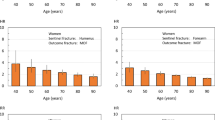Abstract
Summary
Based on an extensive cohort study over 25 years, the present study supports the assumption that major osteoporotic fractures can be reasonably predicted from hip fracture rates.
Introduction
The construct for FRAX models depends on algorithms to adjust for double counting of fracture outcomes in some models and in others, to estimate the incidence of a major fracture from hip fracture rates. The aim of the present study was to test the validity of these algorithms in a large prospective cohort.
Methods
The incidence of hip, clinical spine, distal forearm, and humerus fracture was determined in the prospective and ongoing population-based Reykjavik Study with follow up of 257,001 person-years. The incidence of a first major fracture was compared with the correction factors used in FRAX to adjust the incidence of several fracture outcomes for double counting. In addition, the incidence of a major osteoporotic fracture estimated from the Icelandic hip fracture rates was compared with the Malmo ratios used in FRAX.
Results
The adjustments necessary to account for multiple fracture outcomes were similar to those previously derived from Sweden. Additionally, incidence of a first major osteoporotic fracture was similar to that derived for FRAX models.
Conclusion
The findings of the present study support the algorithms used in FRAX to estimate the incidence of a first major fracture and the predictive value of hip fracture for other major fractures.



Similar content being viewed by others
References
Kanis JA on behalf of the World Health Organization Scientific Group (2008) Assessment of osteoporosis at the primary health-care level. Technical Report. WHO Collaborating Centre, University of Sheffield, UK. Available at http://www.shef.ac.uk/FRAX/index.htm
Kanis JA, Johnell O, Oden A, Johansson H, McCloskey EV (2008) FRAX™ and the assessment of fracture probability in men and women from the UK. Osteoporos Int 19:385–397
Kanis JA, Johnell O, Oden A et al (2000) Long-term risk of osteoporotic fractures in Malmo. Osteoporos Int 11:669–674
Kanis JA, Hans D, Cooper C, The Task Force of the FRAX Initiative et al (2011) Interpretation and use of FRAX in clinical practice. Osteoporos Int 22:395–411
Siggeirsdottir K, Aspelund T, Jonsson BY et al. (2014) Epidemiology of fractures in Iceland and secular trends in major osteoporotic fractures 1989–2008. Osteoporos Int. Epub ahead of print July 2, with erratum Oct 22
Bjornsson OJ, Davidsson. D., Olafsson H, Olafsson O, Sigfusson N, Thorsteinsson T Th (1979) “Report XVIII. Health Survey in the Reykjavik Area. — Men. Stages I–III, 1967–1968, 1970–1971 and 1974–1975. Participants, Invitation, Response etc.”
Bjornsson GBO, Davidsson D, Kristjansson B Th, Olafsson O, Sigfusson N, Thorsteinsson Th (1982) “Report abc XXIV. Health Survey in the Reykjavik Area — Women. Stages I–III, 1968–1969, 1971–1972 and 1976–1978. Participants, Invitation, Response etc.”
World Health Organization (2012) International Statistical Classification of Diseases and Related Health Problems 10th Revision. http://www.who.int/classifications/icd/en/. Accessed 15 Apr
Siggeirsdottir K, Aspelund T, Sigurdsson G et al (2007) Inaccuracy in self-report of fractures may underestimate association with health outcomes when compared with medical record based fracture registry. Eur J Epidemiol 22:631–639
Kanis JA, Oden A, Johnell O, Jonsson B, de Laet C, Dawson A (2001) The burden of osteoporotic fractures: a method for setting intervention thresholds. Osteoporos Int 12:417–427
Bow CH, Cheung E, Cheung CL et al (2012) Ethnic difference of clinical vertebral fracture risk. Osteoporos Int 23:879–885
Sund R, Olliekainen L, Honkanen R, Kroger H (2013) How well hip fractures can be captured using the postal enquiry? J Bone Miner Res 28(Suppl 1):S292
Schousboe JT, Paudel ML, Taylor BC et al (2013) Magnitude and consequences of misclassification of incident hip fractures inlarge cohort studies: the Study of Osteoporotic Fractures and Medicare claims data. Osteoporos Int 24:801–810
Lesnyak O, Ershova O, Belova K et al (2012) Epidemiology of fracture in the Russian Federation and the development of a FRAX model. Arch Osteoporos 7:67–73
Melton LJ (1995) Epidemiology of fractures. In: Riggs BL, Melton LJ (eds) Osteoporosis: etiology, diagnosis and management, 2nd edn. Lippincott-Raven, Philadelphia, pp 225–227
Johnell O, Gullberg B, Kanis JA (1997) The hospital burden of vertebral fracture. A study of national register sources. Osteoporos Int 7:138–144
Olafsdottir E, Aspelund T, Torfadottir JE et al (2012) Early life residency associated with the risk of developing type 2 diabetes—the population-based Reykjavik Study. Laeknabladid 98:639–644
Lam A, Leslie W, Lix L, Yogendran M, Morin S, Majumdar S (2013) Major osteoporotic to hip fracture ratios in Canadian men and women with Swedish comparisons: a population based analysis. J Bone Miner Res. doi:10.1002/jbmr.2146
Acknowledgments
We thank the participants in the Reykjavik Study for their valuable contribution.
Conflicts of interest
None.
Author information
Authors and Affiliations
Corresponding authors
Rights and permissions
About this article
Cite this article
Siggeirsdottir, K., Aspelund, T., Johansson, H. et al. The incidence of a first major osteoporotic fracture in Iceland and implications for FRAX. Osteoporos Int 25, 2445–2451 (2014). https://doi.org/10.1007/s00198-014-2777-3
Received:
Accepted:
Published:
Issue Date:
DOI: https://doi.org/10.1007/s00198-014-2777-3




